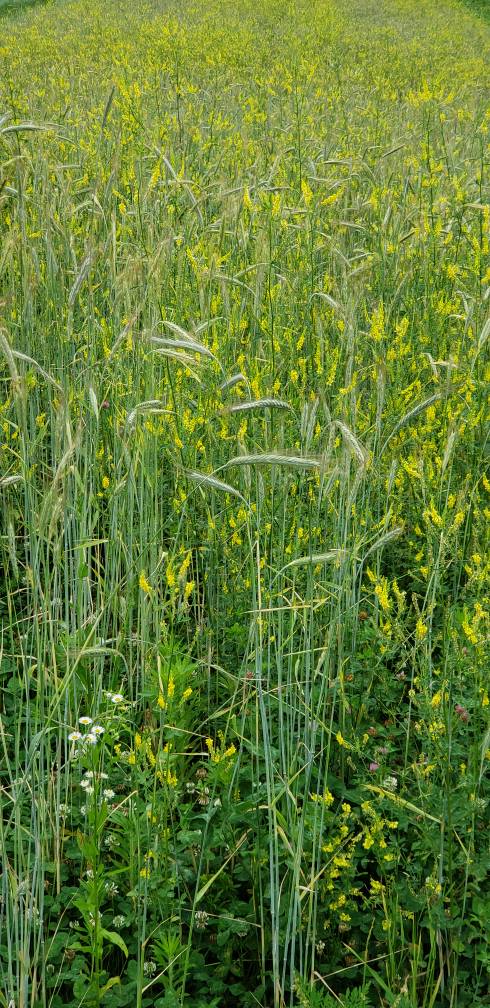Mennoniteman
Well-Known Member
After reading and researching about sweet clovers I decided to experiment with yellow blossom sweet clover and overseeded a field that had a nice stand of well-established ladino clover growing for several years. I like the soil building properties, and the wildlife benefits, but now I'm almost wondering if I made a mistake in introducing it, since it's taken off like an invasive species.

Here's an introduction I pulled off Smith Seed Services website;
Yellow Blossom Sweet Clover
The plant looks like alfalfa and puts out a distinct sweet aroma, the source is coumarin, used to develop the anti-coagulant drug ‘warfarin’. Since these anti-coagulant properties were found to be detrimental to grazing livestock modern sweetclover varieties have been bred to be low in coumarin. Yellow blossom sweetclover persists better in pastures and tolerate adverse conditions better than white varieties. Sweetclover can produce and deposit a high percentage of hard seeds that persist in the soil for many years. This accounts for its consistent volunteering in many areas.
Drought tolerant and winter hardy.
Yellow blossom is one of the most drought-tolerant of forage legumes, and is quite winter-hardy. In temperate climates with mild summers it can survive and thrive through a second year of production. Sweetclovers grows where alfalfa, red clover and white clover fail, such as on clay pan soils or on sands and tolerates low fertility and wet conditions. Yellow blossom prefers non-acid soil (pH above 6.0).
This plant goes deep.
While not a huge forage producer (under 3 tons/acre), yellow blossom sweet clover has a valuable taproot growth that penetrates deep down in soil up to eight feet. This deep tap root and root branches give sweetclover a greater ability than most other cover crops in extracting potassium, phosphorus and other soil nutrients from insoluble minerals. Root branches take in minerals from seldom-disturbed soil horizons, nutrients that become available as the tops and roots decompose.
Nitrogen producer.
Yellow blossom sweetclover contributes up to 275 lbs. N/A and adding valuable organic matter. National Academy of Sciences values for sweetclover: crude protein 15%; digestible protein 10.2%.
Here's a video clip of mowing my Yellow Blossom Sweet Clover/ Ladino mix, the Sweet Clover seems to be taking over the field, although the Ladino is still going strong in the understory, it'll be interesting to see who wins out here.

Here's an introduction I pulled off Smith Seed Services website;
Yellow Blossom Sweet Clover
The plant looks like alfalfa and puts out a distinct sweet aroma, the source is coumarin, used to develop the anti-coagulant drug ‘warfarin’. Since these anti-coagulant properties were found to be detrimental to grazing livestock modern sweetclover varieties have been bred to be low in coumarin. Yellow blossom sweetclover persists better in pastures and tolerate adverse conditions better than white varieties. Sweetclover can produce and deposit a high percentage of hard seeds that persist in the soil for many years. This accounts for its consistent volunteering in many areas.
Drought tolerant and winter hardy.
Yellow blossom is one of the most drought-tolerant of forage legumes, and is quite winter-hardy. In temperate climates with mild summers it can survive and thrive through a second year of production. Sweetclovers grows where alfalfa, red clover and white clover fail, such as on clay pan soils or on sands and tolerates low fertility and wet conditions. Yellow blossom prefers non-acid soil (pH above 6.0).
This plant goes deep.
While not a huge forage producer (under 3 tons/acre), yellow blossom sweet clover has a valuable taproot growth that penetrates deep down in soil up to eight feet. This deep tap root and root branches give sweetclover a greater ability than most other cover crops in extracting potassium, phosphorus and other soil nutrients from insoluble minerals. Root branches take in minerals from seldom-disturbed soil horizons, nutrients that become available as the tops and roots decompose.
Nitrogen producer.
Yellow blossom sweetclover contributes up to 275 lbs. N/A and adding valuable organic matter. National Academy of Sciences values for sweetclover: crude protein 15%; digestible protein 10.2%.
Here's a video clip of mowing my Yellow Blossom Sweet Clover/ Ladino mix, the Sweet Clover seems to be taking over the field, although the Ladino is still going strong in the understory, it'll be interesting to see who wins out here.
Last edited:




